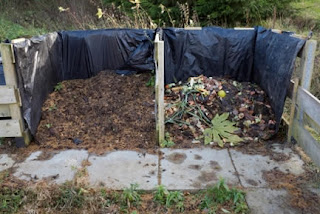The ideal compost heap should be 3 feet wide x 3 feet long x 3 feet tall. It quickly will shrink by as much as 50 percent. That's a good sign that the material is breaking down. An additional way to check if the compost heap is working is to reach your hand inside. The compost and surrounding air should feel warm.
A compost pile should be contained so it attains a minimum height of 3 feet. A simple 3-sided wire mesh fence on posts, wood-flats or stacked hay- /straw-bales will work. If you are starting your first compost pile, dig a shallow hole and build your compost heap within the hole. This will help introduce earthworms to your compost heap to aid in the break down of your materials and invite other microorganisms to speed up the process. If you are using a pre-made container with a closed bottom, place a shovel of dirt into the bottom first, along with a small container of earthworms (can be found in the "fishing section" of most big-box retailers and convenience stores).
Alternate 4- to 6- thick layers of brown materials (dry leaves, straw, and wood shavings) that are high in carbon, and green materials (grass clippings, manure, and kitchen scraps... but NO meat or dairy) that are high in nitrogen. Sprinkle a water and garden soil in between layers to increase heat production, and thus, speed up the process of breaking down the materials. Additionally, a compost inoculant may be added to further increase microbial activity in the compost heap.
Once per week, turn the pile with a pitch-fork. Turning adds oxygen, like stoking a stove, that will help the compost to "cook" faster. After turning, add water to the heap. When the compost heap is properly watered, the materials feel like a wrung-out sponge... neither soggy or bone dry. By using this technique, the break down process will take about 6 weeks to produce finished, usable compost.
Microorganisms work heavily in your compost, and thus, need approximately 3 times as much carbon as nitrogen. Carbon is an intragal part in making compost, and yet, is most commonly found in the fall dry leaves. An easy carbon solution while composting during the spring and summer seasons is to stockpile leaves collected in the fall and add them one layer at a time in your compost heap.
The most commonly heard complaint about composting is this: There is never enough compost. The more a gardener makes, the more they use in their various gardens. :)
Compost Ingredients:
Browns (Carbon):
**need 2- 3 times as much Browns as Greens (Nitrogen)
-Dry Leaves
-Brown plant wastes
-Shredded newspapers, cardboards
-Wood chips, sawdust
-Corn stalks
-Used potting soil
Greens (Nitrogen):
-Manure
-Grass clippings
-Garden wastes
-Kitchen wastes
-Kelp meal
-Blood meal
-Alfalfa
-Human hair


No comments:
Post a Comment